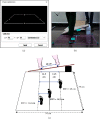A Cross-Sectional Study on Fall Direction and Lower Limb Loading in Response to a Perturbation on Laterally Inclined Platform
- PMID: 37928743
- PMCID: PMC10624552
- DOI: 10.1155/2023/7385119
A Cross-Sectional Study on Fall Direction and Lower Limb Loading in Response to a Perturbation on Laterally Inclined Platform
Abstract
Perturbation-based balance training (PBT) improves reactive stepping in older adults and people with neurological disorders. Slip-induced falls are a threat to older adults, leading to hip fractures. Fall-prone individuals must be trained to regain balance during a fall in the posterolateral direction. This study aims to analyze the characteristics of the reactive step induced by a laterally inclined platform. This cross-sectional study included 46 healthy participants who performed a "lean and release" backward fall using a platform with two inclined angles on each side. Kinovea software was used to analyze the step width. Reactive steps, characterized by crossover or medial foot placement, are preventive measures against posterolateral falls. The first objective was on the narrowed step width that was subjected to analysis using analysis of variance (ANOVA) and Tukey's post hoc assessment, indicating a tendency toward posterolateral falls. As part of our second objective, the inclined platform resulted in uneven loading between the legs, with a preference for the unloaded leg as the reactive leg (p < 0.001), as determined by Fisher's exact test and Cramer's V. These characteristics align closely with those observed in modified constraint-induced movement therapy (mCIMT). The angled platform had a significant effect on selecting the reactive leg, particularly at higher angles (p < 0.001). Thus, the study suggested that the device is capable of inducing posterolateral falls and exhibited mCIMT characteristics.
Copyright © 2023 Jaison Jacob Mathunny et al.
Conflict of interest statement
The authors declare that they have no conflicts of interest.
Figures




References
-
- Pai Y.-C., Bhatt T., Yang F., Wang E. Perturbation training can reduce community-dwelling older adults’ annual fall risk: a randomized controlled trial. The Journals of Gerontology Series A: Biological Sciences and Medical Sciences . 2014;69(12):1586–1594. doi: 10.1093/gerona/glu087. - DOI - PMC - PubMed
LinkOut - more resources
Full Text Sources
Research Materials

